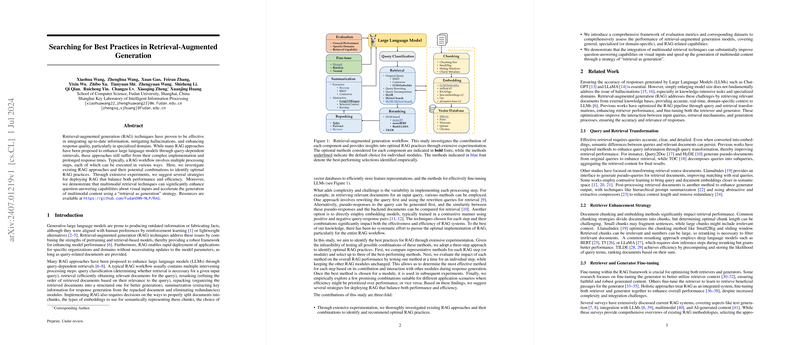Searching for Best Practices in Retrieval-Augmented Generation: An In-Depth Analysis
Overview
The paper "Searching for Best Practices in Retrieval-Augmented Generation," authored by Xiaohua Wang et al., provides a comprehensive examination of the optimal strategies for implementing Retrieval-Augmented Generation (RAG) systems. RAG techniques have demonstrated significant promise in integrating up-to-date information, reducing hallucinations, and enhancing response quality within LLMs, particularly in specialized domains. This paper systematically investigates various RAG methodologies, evaluating their combinations through extensive experimentation to identify practices that balance performance and efficiency.
Contributions
The paper makes three primary contributions:
- Extensive Experimental Evaluation:
- It rigorously evaluates existing RAG approaches and their potential combinations to recommend best practices.
- The paper employs a thorough experimental design to compare methods for each RAG component, selecting the best-performing methods based on empirical results.
- Development of Evaluation Metrics and Frameworks:
- The authors introduce a comprehensive framework with evaluation metrics covering general, specialized, and RAG-related capabilities.
- These metrics provide a robust means of assessing RAG models, ensuring a detailed analysis of performance across different dimensions.
- Integration of Multimodal Retrieval Techniques:
- The paper explores the integration of multimodal retrieval techniques, substantially improving question-answering capabilities on visual inputs.
- The authors highlight the enhanced efficiency in multimodal content generation using a "retrieval as generation" strategy.
RAG Workflow and Components
The RAG workflow is systematically decomposed into several components, each addressed with detailed experimental evaluations:
- Query Classification:
- This module determines whether a retrieval step is necessary for a given query.
- Different tasks are classified into "sufficient" or "insufficient" categories based on their information requirements, optimizing retrieval steps' necessity and enhancing overall response time.
- Chunking:
- Document chunking enhances retrieval precision by segmenting documents into manageable parts.
- Methods like sentence-level chunking, small-to-big, and sliding window techniques balance semantic preservation with efficiency.
- Vector Databases:
- Vector databases store document embeddings and metadata, enabling efficient retrieval.
- Milvus is identified as the most comprehensive vector database due to its support for multiple index types, scalability, hybrid search, and cloud-native capabilities.
- Retrieval Methods:
- Various query transformation methods, including query rewriting, decomposition, and pseudo-document generation (HyDE), are evaluated.
- Empirical results show that combining lexical search with dense retrieval methods (Hybrid Search with HyDE) achieves the best performance.
- Reranking:
- Reranking reorders initially retrieved documents to enhance relevance.
- MonoT5, a deep LLM reranking method, is identified as the best practice for its balance of performance and efficiency.
- Document Repacking and Summarization:
- Repacking methods, such as "reverse" packing relevant documents at the beginning or end of sequences, optimize subsequent LLM processing.
- Summarization methods like Recomp are preferred for their capability to enhance relevant information extraction while reducing redundancy.
Experimental Results and Analysis
The paper's extensive experimentation spans various NLP tasks and datasets, including commonsense reasoning, fact-checking, open-domain QA, multi-hop QA, and medical QA. The evaluation also incorporates metrics from the Retrieval-Augmented Generation Systems (RAGAs) framework, ensuring a robust assessment.
Key findings include:
- The incorporation of a query classification module improves accuracy and reduces latency.
- Hybrid Search with HyDE stands out in the retrieval module.
- MonoT5 and the reverse repacking method significantly enhance performance.
- While Recomp effectively addresses length constraints, omitting the summarization module can reduce latency in time-sensitive applications.
Multimodal Extension
The research extends RAG to multimodal applications, incorporating text-to-image and image-to-text retrieval capabilities. This multimodal extension leverages the "retrieval as generation" strategy, improving efficiency by retrieving appropriate responses from stored multimodal materials.
Implications and Future Developments
This research provides a foundational analysis of RAG systems, offering best practices and benchmarks for practical implementation. The implications are far-reaching, enhancing the deployment of LLMs in diverse domains requiring up-to-date and contextually relevant information. Future developments could explore joint optimization of retrievers and generators, expand multimodal retrieval to include other modalities such as video and speech, and refine cross-modal retrieval techniques.
Conclusion
This paper offers a meticulous and insightful investigation into optimal RAG practices, highlighting the benefits of various methods through empirical evidence. The contributions pave the way for more effective and efficient RAG systems, underpinning future advancements in AI and LLM applications. The integration of multimodal retrieval techniques further extends the utility of RAG systems, making this research a significant reference point for ongoing and future studies in the field.
